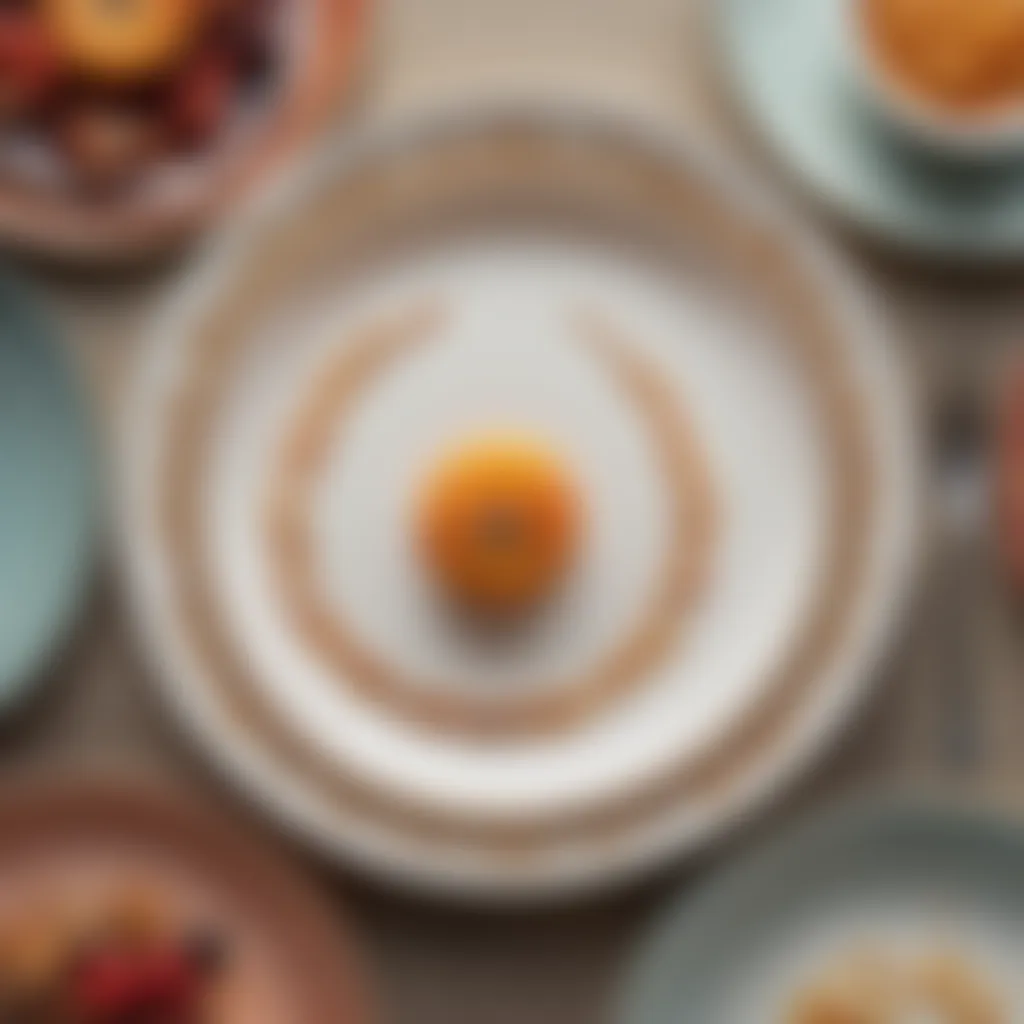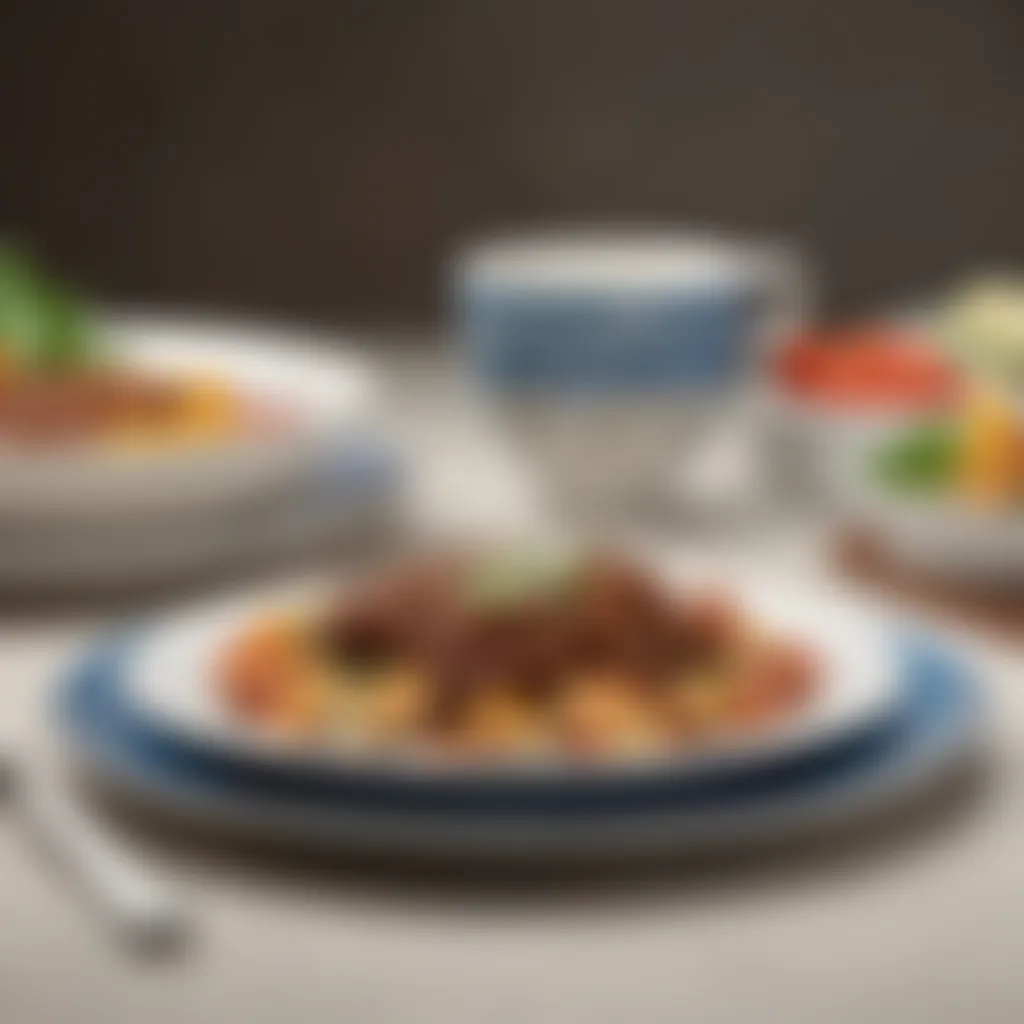The Evolution of Dinner Plates: Trends Through Time


Intro
The humble dinner plate has transitioned from a basic tool for sustenance to a striking canvas, reflecting the flavors of culture, history, and aesthetics. Each plate tells a story—one that weaves through time and space, embodying the changing tides of societal norms and artistic innovations. The journey of dinner plates is not merely about materials and designs, but rather about the profound impact these items have had on our dining rituals and social gatherings.
Whether it’s a rustic, handmade piece adorned with intricate patterns or a sleek, minimalist design crafted through cutting-edge technology, dinner plates have evolved tremendously. They have mirrored our preferences, technological advancements, and even drastic cultural shifts. For the modern housewife, understanding this evolution can offer insights into choosing dinnerware that resonates with personal style while serving its purpose.
In this exploration, we will traverse through the early days of ancient pottery to the sophisticated ceramics of today, delving into how each era's dinner plates reflect their respective societies. Prepare to discover the convergence of art, utility, and social significance encapsulated within these everyday objects.
Historical Context of Dinner Plates
Understanding the historical context of dinner plates can feel like peeling the layers of an onion; each layer reveals something more profound about human culture, artistry, and daily living. The way people dine has evolved dramatically, but at its core lies a tale of functionality shaped by aesthetic preferences. Dinner plates, once mere tools for serving food, have become cultural artifacts that reflect the values and innovations of the societies that produced them.
Throughout history, as civilizations grew and traded, so did the materials and designs of dinnerware. From the early earthenware crafted by primitive hands to the refined porcelain of the East, each era brought forth unique advancements that catered to the evolving needs and tastes of the time. The importance of this context can not be overstated; it provides insight, not just into culinary traditions, but into the very identity of various cultures.
Origins of Dinnerware
The origins of dinnerware take us back to ancient times when simple handmade pottery first appeared. Early humans, primarily concerned with survival, used rough-hewn dishes for practicality. The initial dinner plates served the basic function of holding food, but as societies advanced, so did their approach to serving meals. Decorative elements began to emerge, indicating status or crafting skill.
In ancient Mesopotamia, for example, plates were made from clay and featured intricate designs, showcasing the craftsmanship that was prized in those societies. Similarly, cultures began recognizing the importance of presentation alongside function. Thus, the dinnerware evolution was not merely about the plates themselves but how they represented social standing and artistic expression.
Evolution Through Ancient Civilizations
Greek Pottery
Greek pottery is a significant chapter in the story of dinner plates. The Greeks perfected the art of pottery, creating aesthetically pleasing and functional wares. The key characteristic of Greek pottery was its intricate designs that often depicted mythological scenes, daily life, and worship.
This contributed profoundly to the overall topic, as these plates served both as dining implements and as storytelling mediums that communicated cultural values and artistic prowess. Greek pottery's unique feature was its durable nature combined with artistic flair, making it a popular choice during its time. While it could chip or crack, the artistic intrigue often outweighed these disadvantages, securing the plates a faithful place in both households and museums.
Roman Innovations
In Roman times, the dinner plate underwent a critical transformation, incorporating different materials and techniques. The Romans innovated with the use of glass and metal, introducing new aesthetics and functionalities. Their key characteristic was adaptability; Roman plates were designed to cater to both everyday meals and extravagant feasts.
In addition, the Romans popularized the use of molded plates, setting a precedent for mass production. This not only made dinnerware more accessible but also allowed for variations in design. However, the inclusion of fragile materials like glass led to some disadvantages, primarily the risk of breakage. Nevertheless, the innovations of the Romans significantly influenced the future directions of dinner plate design.
Chinese Porcelain
The advent of Chinese porcelain marked a turning point in dinnerware evolution. Known for its delicate beauty and innovative firing techniques, this dinnerware became highly sought after, gaining legendary status on the global stage. The key feature of Chinese porcelain is its sleekness; it allowed for finer designs and utility than earthenware and stoneware.
This style became a beneficial choice for not only the aesthetic but also the practical side of dining, as it was durable yet refined. On the flip side, the higher cost of production made it less accessible compared to simpler dinnerware options. Despite this, its widespread influence is evident in dining cultures around the world, always serving to elevate meals.
Medieval to Renaissance Transitions
As societies transitioned from the medieval to the Renaissance period, dinner plates continued to evolve, reflecting changing tastes and technological advancements. The introduction of new materials, such as tin-glazed pottery and more intricate designs, marked a shift toward more decorative dinnerware. This era also laid the groundwork for the importance of dining etiquette, further entwining the dinner plate with social customs.
Cultural Influences on Dinner Plate Design
Dinner plate design is a fascinating blend of history, culture, and personal expression. Each plate doesn’t just hold food; it reflects the values and traditions of the societies that crafted them. In this narrative, we’ll explore how various cultural influences shape the aesthetics and functionality of dinnerware, illuminating not just what’s on our plates but also the stories behind them.
Regional Variations and Practicalities
European Styles
European styles in dinner plate design often draw upon centuries of artistic tradition and craftsmanship. The emphasis on elegance and functionality makes them popular choices. Differentiation is key; for instance, the renowned porcelain from Limoges, France, showcases intricate designs along with durability.


A predominant feature of European styles is the use of ornate patterns that narrate tales from history or flora and fauna. These designs can enhance the dining experience, making meals feel more opulent. Come mealtime, they serve as a canvas that elevates simple dishes to a feast for the senses.
However, these plates may require special care. Their ornate nature can make cleaning a tad cumbersome, increasing maintenance efforts. Still, their charm often outweighs the drawbacks, especially for those who prioritize style.
Asian Designs
Asian designs present a rich tapestry of cultural influences, especially from China, Japan, and India. These plates often feature minimalistic aesthetics, using colors and patterns that evoke nature and serenity. A central aspect is the careful balance between form and function. For example, traditional Japanese ceramic plates often highlight seasonal changes through design elements.
With the integration of symbols, like the lotus flower, these dinner plates carry deeper meanings, often representing purity and harmony. This feature resonates with many, solidifying Asian dinnerware as a choice for those who wish for their meals to embody philosophy and culture.
On the flip side, while many Asian designs emphasize artful elegance, they may lack some of the robust qualities found in Western ceramics, making them more delicate. Thus, buyers must tread carefully about the balance between beauty and durability here.
Latin American Artistry
Latin American artistry in dinner plate design bursts with color and life, reflecting diverse cultural backgrounds and influences. A key trait is the vibrancy of hues and intricate patterns; for instance, Talavera pottery from Mexico is famous for its hand-painted designs that echo the region’s heritage.
These plates offer not only utility but also a statement piece for any table. The joyous designs engage diners, often creating lively conversations during meals. They delineate a contrast from more subdued styles, encouraging a communal spirit and celebration of culture at mealtime.
That said, the vivid colors and patterns can sometimes be a challenge for coordinating table settings. They might not suit every occasion, particularly more formal ones. Still, for everyday usage, their warm presence is undeniably inviting.
Symbolism in Dinnerware
Traditional Patterns
Traditional patterns in dinnerware emerge from cultural narratives and historical context. These designs often communicate heritage and craftsmanship, keeping alive the stories of artisans through generations. Each swirl or motif is laden with meaning, allowing a deeper connection between the food and the plate.
Choosing plates with traditional patterns often brings personality to a dining experience. They serve as conversation starters and a way to share cultural background with guests. Their inherent charm means they often find a place on display, embodying pride in craftsmanship and tradition.
However, it's essential to consider compatibility with modern kitchen styles, as some traditional designs may clash with contemporary decor, requiring thoughtful pairing.
Color Significance
Color plays a vital role in dinnerware, conveying emotion and perception. Different colors can evoke various feelings and reactions, making them significant in the dining experience. For example, warmer colors like reds and yellows are often associated with appetite stimulation, while cooler colors may promote calmness.
Many cultures have specific interpretations of color. In Eastern traditions, white is typically connected to purity and peace, while in Western contexts, it can signify simplicity and cleanliness. This knowledge can inform choices, making a festive table setting resonate more profoundly with attendees.
Despite their significance, color choices can feel overwhelming at times. Balancing personal aesthetic preferences with cultural meanings becomes essential to creating a cohesive dining experience.
Understanding these elements of dinner plate design enhances not just the dining experience but also appreciates the artistry and cultural relevance behind the pieces we use.
Material Advances in Dinner Plate Manufacturing
The journey of dinner plate evolution is deeply intertwined with the materials used in their production. As societies evolved, so did the choices in dinnerware materials, reflecting not only technological advancements but also changing aesthetic preferences and cultural values. Understanding these material advances is vital, as they represent the convergence of functionality, artistry, and sustainability in dinnerware manufacturing. Each transition brings forth benefits that shape not just how we serve food but also how we perceive the dining experience.
The Shift from Earthenware to Fine China
In ancient practices, earthenware was the go-to option for dinner plates. Made from clay and baked at low temperatures, it was affordable and accessible. However, its porous nature meant it could absorb flavors and stains, which posed a challenge for diners and home chefs alike. The leap to fine china marked a pivotal moment in dinnerware history. Fine china, often composed of kaolin and other minerals, undergoes high-temperature firing. As a result, it retains little to no moisture and resists absorbing flavors or odors. This transformation allowed for a more refined dining experience, where aesthetic appeal was matched by practicality.
The intricate designs and sheer elegance of fine china contrived to elevate meals into an art form. The durability of these plates prevents the need for constant replacement, allowing them to be cherished family heirlooms. Yet, the environmental impact of producing fine china, such as energy consumption and raw materials used, poses important considerations for today's environmentally conscious diners.
Innovations in Modern Materials
Porcelain vs. Stoneware


In the ongoing exploration of dinner plate materials, porcelain and stoneware stand out for their contrasting characteristics. Porcelain is celebrated for its translucency and delicate beauty. It's resistant to chipping, making it a popular choice for both daily use and special occasions. On the other hand, stoneware boasts unmatched durability and strength. It's less prone to breakage and handles the rigors of everyday life, making it an ideal choice for busy kitchens.
Thus, many nowadays find themselves favoring stoneware for casual dining, while porcelain retains its charm at more formal gatherings. Both types offer diverse design options that can cater to varying tastes, whether minimalist or ornate.
"The choice between porcelain and stoneware often comes down to personal lifestyle needs, affecting both functionality and aesthetic preferences."
Biodegradable Alternatives
With the growing awareness of environmental sustainability, biodegradable alternatives are gaining traction in the dinnerware market. These materials, crafted from natural sources such as bamboo or palm leaves, not only reduce plastic dependency but also biodegrade after use. Their lightweight design is complemented by an ability to withstand hotter temperatures, making them practical for a variety of foods.
An interesting aspect of biodegradable alternatives is their eco-friendliness, which aligns perfectly with the desires of modern households seeking to reduce their environmental footprint. However, one must consider the durability factor; these plates can be less sturdy and may not withstand heavy use over time.
In summary, as the world moves towards innovation, the evolution of dinner plate materials continues to be a reflection of societal changes, preferences, and technological advancements. This exploration illustrates how the fabric of our dining culture adapts to embrace new methods and philosophies in plate manufacturing.
Current Trends in Dinner Plate Designs
The evolution of dinner plates ain't just about looks; it's a telling sign of our times, touching on various tastes, preferences, and the larger global narrative. In today’s culinary world, the dinner plate plays a pivotal role—not just as a holder of food, but as a canvas displaying artistry and sentiment. The trends emerging now give insight into what people value in their dining experiences and reflect broader societal shifts.
Minimalist Aesthetics
Minimalism has taken the design world by storm, and dinner plates are no exception. The key here revolves around simplicity and functionality. Plates crafted with minimalist principles often boast clean lines, subtle colors, and a focus on form over ornamentation.
This aesthetic allows the food to shine, creating an inviting tableau. Rather than competing with the culinary masterpiece, these plates highlight the flavors and colors of the meal. Not only do they appeal to the eye, but they also provide incredible versatility, fitting into various dining styles—from casual dinners to formal occasions.
Sustainable and Eco-Friendly Options
The clamor for sustainability has permeated every facet of life, including what sits on our tables. Eco-friendly dinnerware options are now trending, catering to environmentally conscious consumers. Materials like bamboo, recycled glass, and plant-based composites feature prominently in this space. Using these materials not only reduces waste but also promotes conscious dining habits.
Furthermore, buyers are increasingly interested in products that tell a story—where they come from, how they’re made. Plates that are sustainably sourced can connect people to the environment, urging them to think more about their choices. Going green has become not just a trend but also a lifestyle.
The Role of Technology in Design
Technological advancements have opened the floodgates for innovation in dinner plate design, merging the functional with the futuristic.
3D Printing Techniques
3D printing is reshaping how dinner plates are created, allowing for intricate designs that traditional methods can’t achieve. The chief characteristic of this technology is its capability to personalize; from vibrant colors to unique shapes, each plate can carry a distinctive flair.
What's particularly appealing about 3D printing is the quick prototyping process. Designers can experiment with new concepts without heavy financial burdens.
However, while the aesthetic appeal is undeniable, durability can sometimes be a concern, as not all 3D-printed materials hold up as well as traditional ceramics. Therefore, while the technology offers boundless creativity, it's important to weigh the practical aspects.
Smart Dinnerware Innovations
Another exciting trend is the rise of smart dinnerware. These innovations include plates equipped with sensors that can monitor food temperature or even gauge portion sizes. The intriguing aspect of smart dinnerware is its ability to enhance the dining experience—making it more interactive. For instance, a plate that lights up to indicate ideal serving temperatures can enhance both taste and safety.
Yet, these futuristic plates come with their own set of challenges. They require batteries, or charging, which can be a hassle. Additionally, some may argue that this level of technology could detract from the simplicity and enjoyment of the meal.
Impact of Dinner Plates on Culinary Presentation
Dinner plates do more than just hold food; they are pivotal in the overall dining experience. These platters are the canvases where culinary art meets aesthetic presentation. More often than not, how a dish is plated can impact not only the pleasure of the senses but also the perception of the meal itself. In this segment of the article, we'll explore the various ways dinner plates affect both presentation and viewer reception, emphasizing their importance in elevating a dining experience beyond the meal itself.
When one hears the phrase "you eat with your eyes first," the emphasis lies on the visual appeal of food. By using dinner plates that complement the color and texture of the dish, diners can enhance the overall experience. For example, a vibrant tomato salad served on a stark white plate provides a sharp contrast that can make the colors pop. This visual stimulation can create an initial excitement before a single bite is taken. Most importantly, it can also make even the simplest dish look gourmet.


The Psychology of Plate Presentation
How a meal is presented carries significant weight in terms of psychology. The term "plate appeal" refers to the aesthetic charm of arranged dishes and its psychological effects on eaters. There are several psychological principles at play when it comes to the way food is organized and displayed.
- First Impressions Matter: The arrangement of food can evoke different emotions or cravings, creating anticipation. A neat arrangement often suggests care and precision, while a messy plate can imply haste or lack of interest.
- Color and Contrast Influence Taste Perception: The vibrancy of food can sway one’s expectations of flavor. Brightly colored foods naturally create expectations for fresh, tantalizing tastes. Interestingly, studies indicate that dishes served on brighter plates also create the perception of larger portion sizes, which can be a psychological strategy in meal design.
- Familiarity and Tradition: Food influences how people approach dining. If certain dishes remind a person of tradition or family gatherings, they might derive deeper pleasure simply based on their relationship with the dish and its presentation on the plate.
"The plate is a visual promise of what the food can deliver, enticing us to savor the experience."
Cultural Significance of Dish Arrangements
Cultural perspectives have considerable influence over how food is plated. Different societies embrace various themes and aesthetics in how meals are presented, stemming from history, traditions, and even symbolic meanings. Here are some notable aspects:
- Cultural Identity: Certain cultures prefer specific arrangements that showcase particular food types. For example, in Japanese cuisine, the Kaiseki style emphasizes the seasonal beauty of ingredients and balances color, taste, and texture in each dish. Conversely, an Italian family might serve pasta on a large communal platter, encouraging shared dining.
- Symbolism in Serving Practices: The way food is plated can also carry significant meaning. In many cultures, breaking bread together symbolizes unity. Arranging a communal meal on a large dish can enhance social bonds, reflecting the significance of sharing.
- Artistry in Tradition: Certain cultures have long-standing artistic practices tied to food presentation. Middle Eastern plating often involves intricate arrangements and patterns, drawing the eye and stimulating an appreciation for culinary art.
Artistic Expressions in Dinner Plate Crafting
Artistic expressions in dinner plate crafting serve as a captivating bridge between functionality and aesthetic appeal. These plates are not merely tools for serving food; they embody cultural tales, personal creativity, and artistic mastery. From the intricate patterns hand-painted by artisans to the bold, minimalist designs of modern creators, every plate tells a story. The significance of these expressions lies in their capacity to elevate the dining experience and connect people to their heritage, culinary practices, and even emotional experiences.
Unique dinner plates can reflect individual taste and lifestyle while fostering connections during shared meals. The vibrant colors or delicate textures often influence the way food is perceived. An exquisite plate can enhance the presentation, making the dishes look more appetizing. Capturing one's personal style on a dinner plate opens avenues for creativity and self-expression in the often-routine act of dining. Moreover, how these plates resonate with the way we feel about food—inviting nostalgia, comfort, or perhaps even excitement—is a consideration that cannot be overlooked when discussing their artistic elements.
"A beautifully crafted plate can transform an ordinary meal into a feast for the senses, merging sustenance with art."
Historical Artists and Their Influence
The history of dinner plate design is punctuated by the creativity of artists who have influenced their evolution significantly. Artists of the past, particularly in regions reputed for ceramics, have often poured their culture and personal flair into their creations. For instance, in Europe, the finesse of the Meissen porcelain artisans in the 18th century set high standards for quality and artistry. Their plates depicted scenes of pastoral beauty or mythological references, demonstrating an intersection of practicality and heavy decoration—one that appealed to the nobility.
In Japan, the beauty of Imari ware, with its vibrant colors and intricate designs, showcased the mingling of Japanese aesthetics with international influences, particularly during the Edo period. The use of cobalt blue and red enamels in these plates captivated the Western market, signaling the power of art to transcend geographical borders.
These historical figures have laid the groundwork for contemporary styles, reminding us that dinner plates have always had a dual purpose: functional tableware and an exhibition of craftsmanship.
Modern Artists Exploring Dinnerware
Today, a fresh wave of artists is reimagining dinnerware, integrating diverse styles and modern techniques. These creators are not stuck in tradition but rather push boundaries, melding art with usability. Their practices often embrace sustainability, using recycled materials and eco-friendly processes, thus marrying artistry with a sense of responsibility towards the planet.
Modern artists such as the ceramicist Baileigh Kiker focus on creating pieces that speak to their artisanal roots while incorporating contemporary design philosophies. Her work often features geometric patterns and organic shapes that delight the eye while remaining functional. Furthermore, social media platforms like Instagram have granted these artists a forum to showcase their work to a wider audience, allowing for an even richer exchange of ideas in the dinnerware domain.
In essence, these modern-day creatives are not merely continuing a legacy; they’re innovating it, embracing technology while staying true to the heart of craftsmanship. As the landscape of dinnerware evolves, the artistic expressions found in these plates remain crucial, reflecting our ongoing relationship with design, culture, and food.
Future Directions in Dinner Plate Evolution
The landscape of dinner plate design is shifting like sand beneath our feet, pointing towards new horizons that reflect the zeitgeist of contemporary society. Ignoring this evolution could leave one at the mercy of yesterday’s trends. This section offers a glimpse into how future directions will profoundly shape the aesthetics and functionality of our dining experiences.
Predicted Trends in Aesthetic Preferences
As we gaze into the crystal ball of design, it’s clear that versatility will reign supreme. Gone are the days when dinner plates merely served their purpose as functional objects. Instead, they are becoming statements, merging art with utility. One predicted trend is the rise of geometric shapes and asymmetrical designs that challenge traditional notions of round plates. These new forms don’t just catch the eye; they create conversation, transforming any meal into an occasion.
Additionally, the embrace of natural motifs – think floral patterns and earthy hues – reflects a growing appreciation for nature. People are increasingly seeking organic materials in their dinnerware, aligning with an eco-conscious lifestyle while also injecting a touch of freshness into their table settings.
"In design, the art of the plate is as important as its use. A beautifully crafted plate can elevate a simple meal into a splendid experience."
In the wake of globalization, there’s also a noteworthy pivot towards fusion styles, blurring the lines between different cultures. Dinner plates adorned with Japanese minimalism intertwining with Italian rustic charm reflect not only culinary diversity but also the modern diner's quest for meaningful connections.
Advancements in Sustainable Practices
Sustainability is no longer just a buzzword; it’s woven into the very fabric of modern dining. Future directions in dinner plate production are significantly reliant on the advancement of sustainable practices. Manufacturers are exploring biodegradable materials like bamboo or palm leaf, which, unlike traditional plastics, won’t linger in landfills for centuries.
Innovations like recycled glass and ceramics are gaining momentum, transforming waste into beautiful, functional art. This shift not only addresses environmental concerns but also provides a unique storytelling element for each piece, as every plate might carry its history from scraps to elegance.
Furthermore, we’ll likely see an increase in locally sourced materials, spurring local economies and reducing carbon footprints. Think about it: supporting artisans who create dinner plates from materials found in their own backyards. This not only preserves local culture but also ties the possibility of a meal directly to its origins.







